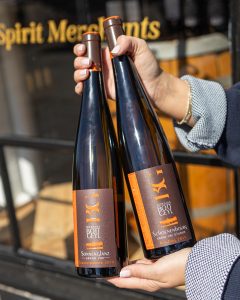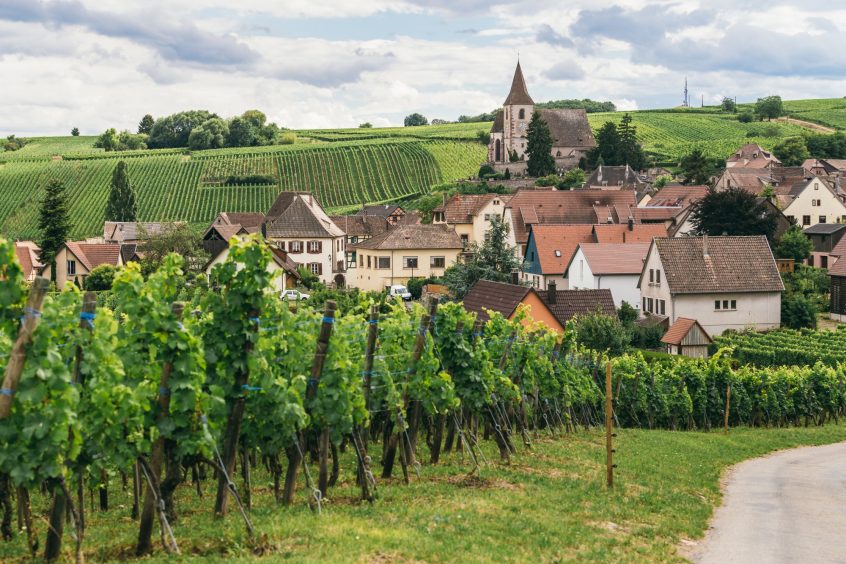Nestled between the Vosges Mountains to the west and the Rhine River to the east, the Alsace wine region benefits from a distinctive terroir shaped by its complex geology and sheltered microclimate. The rain shadow cast by the Vosges makes Alsace one of the driest wine regions in France, allowing for slow, consistent grape ripening and the development of highly aromatic compounds. The region’s soils are a mosaic of granite, limestone, schist, clay, and volcanic sediment – each contributing to the nuanced expression of its varietals. Alsace specializes in noble white grapes such as Riesling, Gewürztraminer, Pinot Gris, and Muscat, often vinified as single-varietal wines to highlight their purity and minerality. With its clearly defined Grand Cru system and a strong emphasis on terroir, Alsace offers some of the most site-expressive white wines in the world.
Class System and Labelling
Wine labels and classifications in Alsace are quite different to much of France, with a crucial different being the inclusion of grape variety listed on the label.
Their labels may also include other terms. For example, ‘Vendanges Tardives’, which literally translates to ‘late harvest’, indicating a sweet wine produced from grapes harvested later in the season. Another term you may see is Selection de Grains Nobles, which again indicates sweet wines. These wines include grapes affected by noble rot, giving them very sweet, concentrated profiles. Alongside these terms, they also typically include a reference to the level of sweetness in their wines, ranging from dry to sweet, usually represented on a scale on the back label. Producers began using these scales in recent years to show that many Alsatian wines were dry, appealing to market demand, and ultimately making it easier for the consumer!
Climate and Topography
Despite its northerly location, Alsace actually enjoys a rather dry and sunny climate, as a result of its protection by the Vosges mountains to the west. Its location inland means that the vineyard areas have a continental climate, with very cold winters and warm, sunny summers. As westerly winds carry rain clouds, the Vosges mountains act as a barrier, so the eastern side of the mountains endure only around 600mm of rain per year, less than half of that on the western side. This, alongside the high sunshine hours, creates a perfect growing environment for wines which are marked by high acidity.
The foothills of the Vosges mountains provide many, and diverse vineyard sites at a range of altitudes, creating optimal conditions for a variety of grapes. The best vineyards are often found at approximately 200-250 metres above sea level, though so some sit much higher. These typically face south-east or south-west for maximum sunlight exposure.
Domaine Bott Geyl
The Bott-Geyl estate was founded by two families in the heart of Alsace. The Bott’s had cultivated vines since the 19th Century in Ribeauville. The Geyl’s were just a short distance away in Beblenheim, and they had been producing wine since the end of the 18th Century. In 1926, Andree Geyl and Frederic Paul Bott married, forming Domaine Bott Geyl. 
Over many years, they expanded their production, from 4 to 14 hectares over 40 years. By 1993, they had explored some of the world’s most renowned winemaking regions, using the knowledge they acquired to improve their technologies and ultimately the quality of the wine. Today the estate covers 18 hectares, including 6 Grands Crus, 3 lieux-dits, and 1 historic Clos, Le Clos des 3 Chemins.
Their estate operates under biodynamic and organic practices, as they keep the sustainability and preservation of the vineyard at the forefront of their operations. They also use minimal intervention in their winemaking, allowing nature to take its course and allowing the wine to reflect terroir and vintage. The results are wines which overtly show complexity, intensity and a distinctive style.
We are pleased to offer a fantastic selection of wines from this estate. All of which perfectly represent the level of quality in premium Alsatian wines.
Winemaking
A key feature of Alsatian winemaking is the fact that their wines are most often vinified as single varietals. Where many renowned French wines are recognised for their blends, such as Bordeaux or Southern Rhone, Alsace instead focuses on expressing varietal character. This is so crucial for the types of wines which they produce, because they are, for the most part, aromatic varieties which are best expressed in wines which allow their character to shine through.
For example, Riesling is a grape which is easily recognisable, noted for its high acidity and aromatic profile with notes of orchard fruit, citrus, jasmine, and even kerosene. Its aromas are intense, with some of the finest examples coming from Alsace. Riesling here is typically dry, with a lot of primary fruit in youth, but with fantastic capacity to age.
Another grape which is practically synonymous with Alsace is Gewurztraminer. Again, this a variety with very pronounced, unique aromas. On the nose, lychee and rose dominate, alongside citrus and orchard fruit. These wines are typically medium-full bodied, with medium acidity and real complexity. Again being an aromatic grape, with a distinctive profile, it is usually made as a single-varietal wine, though it can be made in a range of styles from dry to sweet.
Alsace is a region famed for their extraordinary single-varietal wines, both dry and sweet, with significant German influence. The character, imagination and wide variety of Alsatian wines is impressive. Whilst it is often one of the more underrated French wine regions, though this can largely be attributed to the fact that they keep almost 75% of production for domestic consumption, it is undeniable that this is one of France’s trendiest, and most exciting wine regions.

